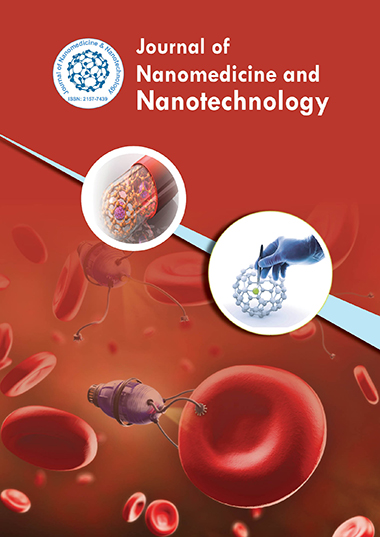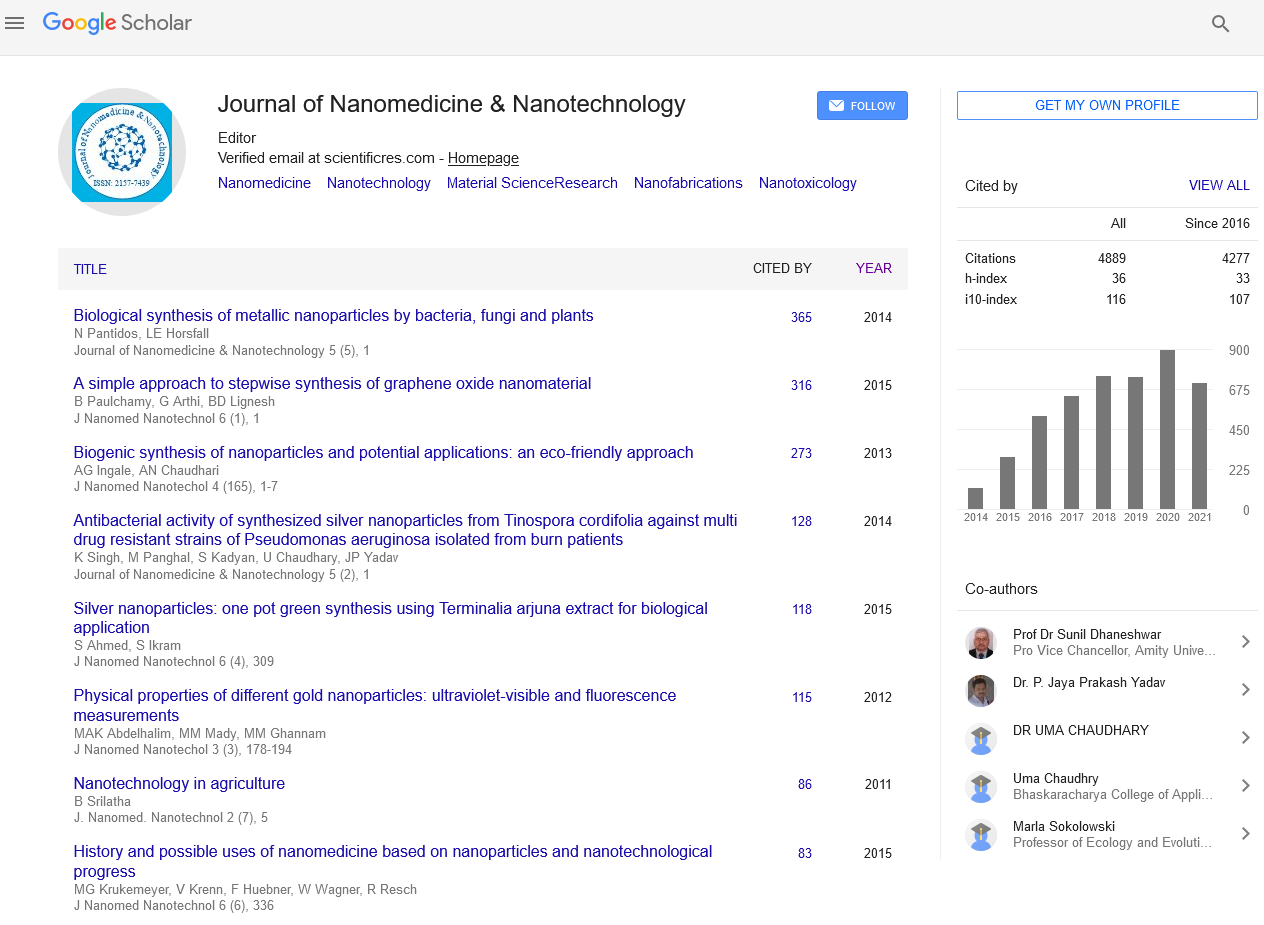Indexed In
- Open J Gate
- Genamics JournalSeek
- Academic Keys
- JournalTOCs
- ResearchBible
- China National Knowledge Infrastructure (CNKI)
- Scimago
- Ulrich's Periodicals Directory
- Electronic Journals Library
- RefSeek
- Hamdard University
- EBSCO A-Z
- OCLC- WorldCat
- SWB online catalog
- Virtual Library of Biology (vifabio)
- Publons
- MIAR
- Scientific Indexing Services (SIS)
- Euro Pub
- Google Scholar
Useful Links
Share This Page
Journal Flyer

Open Access Journals
- Agri and Aquaculture
- Biochemistry
- Bioinformatics & Systems Biology
- Business & Management
- Chemistry
- Clinical Sciences
- Engineering
- Food & Nutrition
- General Science
- Genetics & Molecular Biology
- Immunology & Microbiology
- Medical Sciences
- Neuroscience & Psychology
- Nursing & Health Care
- Pharmaceutical Sciences
Commentary Article - (2025) Volume 16, Issue 2
The Role of Nanofabrication in Next-Generation Electronics and Medicine
Magnolia O Hara*Received: 01-Mar-2025, Manuscript No. jnmnt-25-28606; Editor assigned: 05-Mar-2025, Pre QC No. jnmnt-25-28606 (PQ); Reviewed: 20-Mar-2025, QC No. jnmnt-25-28606; Revised: 25-Mar-2025, Manuscript No. jnmnt-25-28606 (R); Published: 31-Mar-2025
Abstract
Nanofabrication is a cutting-edge field that enables the precise manipulation and structuring of materials at the nanometer scale, paving the way for groundbreaking advancements in electronics and medicine. By leveraging techniques such as lithography, self-assembly, and molecular deposition, nanofabrication facilitates the development of smaller, faster, and more efficient electronic devices as well as highly targeted drug delivery systems and diagnostic tools. This article explores the role of nanofabrication in next-generation electronics and medicine, discussing its key techniques, applications, challenges, and future directions.
Keywords
Nanofabrication; Lithography; Nanoscale manufacturing; Nanoelectronics; Biomedical nanotechnology; MEMS; Drug delivery; Sensors; Nanomedicine; Advanced materials
INTRODUCTION
Nanofabrication is revolutionizing the way materials and devices are designed by enabling precise control over their structure and properties at the atomic and molecular levels. This field is crucial in the advancement of modern technology, particularly in nanoelectronics and biomedical applications, where miniaturization and functionality play a vital role. As the demand for more powerful computing systems, faster data processing, and advanced healthcare solutions grows, nanofabrication techniques are being increasingly adopted to push the boundaries of innovation. This article provides an in-depth analysis of the role of nanofabrication in next-generation electronics and medicine, highlighting its transformative impact and challenges [1,2].
DESCRIPTION
Nanofabrication encompasses a variety of techniques that allow for the structuring of materials at an extremely small scale. The key methods used in nanofabrication include [3].
Lithography techniques: Photolithography and electron beam lithography (EBL) are widely used in semiconductor manufacturing to create nanoscale transistors and circuits in microprocessors and memory devices.
Self-assembly processes: Chemical and biological self-assembly techniques enable the formation of highly ordered nanostructures without the need for external manipulation [4,5].
Thin-film deposition: Methods such as atomic layer deposition (ALD) and chemical vapor deposition (CVD) are used to fabricate ultra-thin films for applications in nanoelectronics and biomaterials.
Nanoimprint lithography: This technique is employed to create nanoscale patterns with high resolution and low cost, offering advantages for mass production [6].
Nanofabrication plays a critical role in two key areas:
Nanoelectronics: It enables the development of ultra-small, high-performance transistors, flexible electronics, and energy-efficient computing devices.
Biomedical applications: Nanofabricated devices such as biosensors, drug carriers, and lab-on-a-chip systems improve diagnostic accuracy, targeted therapy, and personalized medicine [7,8].
DISCUSSION
The impact of nanofabrication in electronics and medicine is profound, leading to faster and more efficient computing technologies as well as more effective and minimally invasive healthcare solutions. However, several challenges must be addressed for widespread implementation.
One of the primary challenges is scalability. While nanofabrication techniques offer precision and control, mass production at an economically viable scale remains difficult. Advanced lithographic techniques such as extreme ultraviolet (EUV) lithography are being developed to overcome these barriers in semiconductor manufacturing.
In biomedical applications, ensuring the biocompatibility and safety of nanostructured materials is a critical concern. Research on long-term effects, toxicity, and regulatory compliance is necessary to facilitate the clinical adoption of nanofabricated medical devices [9,10].
Furthermore, the high costs associated with research and development in nanofabrication pose limitations for widespread adoption. Collaborative efforts between academia, industry, and government agencies are essential to drive innovation while reducing costs.
CONCLUSION
Nanofabrication is a cornerstone of next-generation electronics and medicine, enabling significant advancements in computing power, miniaturized devices, and healthcare solutions. While challenges such as scalability, cost, and biocompatibility remain, continuous research and technological breakthroughs are paving the way for broader adoption of nanofabrication techniques. As the field evolves, its integration into everyday technologies will play a crucial role in shaping the future of electronics and medicine, offering smarter, faster, and more efficient solutions to global challenges.
ACKNOWLEDGEMENT
None
CONFLICT OF INTEREST
None
REFERENCES
- Fulekar M. Nanotechnology: importance and applications. IK International Pvt Ltd. 2010.
- KaradeV, Waifalkar P, Dongle T, Sahoo S C, Kollu P, Patil P et al. Greener synthesis of magnetite nanoparticles using green tea extract and their magnetic properties. Mater Res Express.2017; 4(9): 096102.
- Alfredo V, Isaías J, Hernandez E, Perez S, Angelica L, Landeros Sanchez B. Synthesis and characterization of magnetite nanoparticles for photocatalysis of nitrobenzene. J Saudi Chem Soc.2020; 24(2): 223-235.
- Avasthi A, Caro C, Pozo-Torres E, Leal M P, García‑Martín M L. Magnetic Nanoparticles as MRI Contrast Agents. Topics in current chemistry.2020; 378(3): 40.
- Liu S, Yu B, Wang S, Shen Y, Cong H. Preparation, surface functionalization and application of Fe3O4 magnetic nanoparticles. Adv. Colloid Interface Sci.2020; 102165.
- Almomani F, Bhosale R, Khraisheh M, Almomani T. Heavy metal ions removal from industrial wastewater using magnetic nanoparticles (MNP). Appl Surf Sci.2020; 506: 144924.
- Zulfiqar N. Effect of adding surfactant additives (sodium lauryl sulphate) in water on the performance of flat plate solar distillation system for the purification of water. 2023.
- Poole C P, Owens F J. Introduction to nanotechnology. 2003.
- Mirza S, Ahmad M S, Shah A, Ateeq M. Magnetic nanoparticles: drug delivery and bioimaging applications. 2020; 189-213.
- Iravani S, Korbekandi H, Mirmohammadi S V, Zolfaghari B. Synthesis of silver nanoparticles: chemical, physical and biological methods. Int J Pharm Sci.2014; 9(6): 385.
Indexed at, Google Scholar, Crossref
Indexed at, Google Scholar, Crossref
Indexed at, Google Scholar, Crossref
Indexed at, Google Scholar, Crossref
Indexed at, Google Scholar, Crossref
Indexed at, Google Scholar, Crossref
Indexed at, Google Scholar, Crossref
Citation: Magnolia O (2025) The Role of Nanofabrication in Next-Generation Electronics and Medicine. J Nanomed Nanotech. 16: 782.
Copyright: ©2025 Magnolia O. This is an open-access article distributed under the terms of the Creative Commons Attribution License, which permits unrestricted use, distribution, and reproduction in any medium, provided the original author and source are credited


